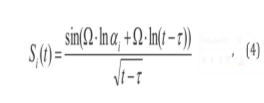The subject of the study is the method of information transmission.
The objective of the study is to improve the efficiency of radio communication by increasing the spatial stealth.
Analysis of spatial and temporal characteristics of radio channel signals.
According to the results of the study, a method for transmitting information with high spatial anonymity has been developed, which is one of the current challenges in the field of telecommunications.
Keywords: method, space-time processing, Fourier transform, frequency modulation, broadband signals, multiplicative processing.
It is recommended to divide the information in advance into two or more streams, each of which is transmitted to a certain point in space over different spatial delivery channels using special carriers. In addition, the information transmitted only at that point is reconstructed by a common phase connection of its components. So far, electron focusing has mainly been used in acoustic imaging systems as well as in radiolocation, taking into account the sphericity of the incident wavefront [1]. A device has the properties of a lens if it can specify a point called the focal length and a point called the focus whose vibrations are perceived with maximum amplification.
Field of application — Transmission of information by radio link. A common disadvantage of existing transmission methods is low spatial anonymity. By monitoring the distribution network, it is possible to obtain information without authorisation, control traffic, and intercept control of channels, which reduces the effectiveness of the means of communication. In order to improve the efficiency of telecommunication systems, a number of contradictory problems need to be solved. On the one hand, it is necessary to increase the signal spectrum width in order to increase the bandwidth and stealth, and on the other hand, spatial selection needs to be ensured. The use of broadband signals in radios installed on manoeuvring high-speed objects does not allow them to realize their potential in terms of bandwidth, interference and noise immunity. This leads to the need to increase the signal strength, thereby hiding the object using the radio mode. It should be noted that broadband signals are poorly processed due to Doppler dispersion. The task of reliable information transmission is especially important for high-speed communications, which allow signaling of transmitting and receiving information, but also increase the risks of interception by the adversary. This article shows one way to resolve this conflict. The choice of carrier is determined by certain multiplicative signal transformations due to the Doppler dispersion.
Conclusions — The proposed technical solution solves the problem of covert information transmission by focusing the energy.
To obtain

where Ω is the hyperbolic carrier frequency,
Ω = f (t)×t; f(t) is the instantaneous frequency;
t — current time moment;
𝜏 — time shift of the signal relative to the start of counting, 𝜏ⱶ — time shift in magnitude, [2], which is equal to the change in range
volume
ΔD = Ⅽ ⅹ 𝜏
where C is the velocity of energy propagation in the medium;

α — Doppler parameter;
V — relative radial velocity.
Indeed, taking into account the Doppler transform S(t) = √(α -S)(αt) the signal in focus takes the form [3]:

where 𝜏' is the delay due to the limited propagation velocity of the electromagnetic oscillations.
That is, the signal propagates with a delay or advance, depending on the sign of the Doppler parameter. This well-known result is a direct consequence of the property of invariance of the LFM (hyperbolic frequency modulation)-signal to the Doppler effect [2, 4].
Focusing the energy of these emitters to a given point can be achieved by artificially introducing into the signals of two emitters (1) predetermined Doppler parameters equivalent to the relative beam velocities of the focusing point with respect to these emitters.
For clarity, let us consider the situation shown in pic. 1, the main parameters are related to:










L is the distance between the emitters;





Fig 1. Position of the transmitter and focus points in space
Таким образом, при формировании сигналов вида

where i is the emitter number;
and fulfilment of conditions (2) and (3) ensures that the signals of the two emitters at a given point in space are phase-tuned.
Based on the linear property of the Fourier transform, the sum of the signals a•




If it is necessary to transmit information via radio channel to a certain point in space, signal of type (4) can be used as an information carrier. In this case its spectrum is represented in two kinds components and equal to their sum, one parameter


The proposed technical solution [6–7] solves the problem of covert information transmission by controlling the focus of energy of the emitters.
References:
- Samoilov L. K. Electronic Antenna Direction Control. — L.: Shipbuilding, 1987. — 280 с.
- Richacek A. B. Signals resolved in terms of the Doppler effect. // LEVEL. — 1966. — Issue. 54. — H 6. P. 39–41.
- Pavlikov S. N., Ubankin E. I. Perspective methods of signal processing in telecommunication systems Vladivostok: Naval State Univ. 2013.-99
- Saprykin V. A., Rokotov SP. Hydroacoustics and theory of digital signal processing, part. 2 — L.: VVMURE, 1991–416 p.
- Siebert W. M. Chains, signals, systems, part 2: translated from English. — Moscow: Mir, 1988. — 360 с.
- Utility model certificate 16576, Russia, Information transmission and reception device / Pavlikov S. N., Ubankin E. N., Bogdanov V. S., Kolenchenko I. A. — fig. 2001, № 1.
- Burenin A. N., Legkov K. E. Effective methods of flow control in protected information communication networks// JEP: Necessary science-intensive technologies in Earth space investigations. — 2010. — № 2. — С. 29–34.







